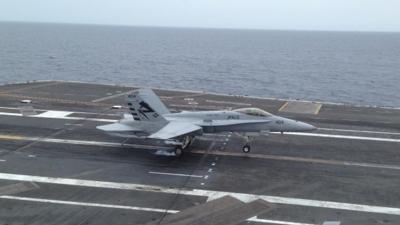Sat, Jun 29, 2013
Joint Precision Approach And Landing System Trials Conducted Aboard USS George H.W. Bush
Landing on an aircraft carrier is now safer thanks to the Joint Precision Approach and Landing System (JPALS) team from the Naval Air Traffic Management Systems Program Office (PMA-213). JPALS is an all-weather landing system that uses a Global Positioning System and navigation systems to safely land both land- and sea-based aircraft. JPALS completed its latest round of testing aboard the USS George H.W. Bush (CVN 77) in late May.

The 52-person team spent 11 days aboard the carrier testing the latest JPALS software with two F/A-18C Hornet aircraft from Air Test and Evaluation Squadron (VX) 23, and an MH-60S helicopter from Air Test and Evaluation Squadron (HX) 21, based at Naval Air Station Patuxent River. A modified Beechcraft King Air flying from St. Mary’s County Airport was also used as a test bed aircraft.
“The Hornets flew 65 low approaches to touch-and-go or full-stop landings during our two weeks on CVN 77,” said Lee Mason, PMA-213’s JPALS Ship System integrated program team lead. “The King Air completed 29 low approaches. So far, we are very pleased with the results. The system is expected to achieve tremendously improved landing accuracy.” With the completion of this two-week test period, the JPALS program transitioned into the second phase of integrated test, establishing the system requirements verification for JPALS, Mason added.
“The data generated from this two-week, at-sea period is undergoing detailed analysis by our experts. This analysis will, in turn, be used to validate and verify the system is accurate and working,” said Capt. Darrell Lack, PMA-213 program manager.
Later this summer, JPALS is scheduled to complete additional at-sea testing to further refine the verification and validation effort and enable the completion of the operational assessment of the JPALS ship system, which is needed to progress to the program’s next milestone, Lack added. “JPALS will provide adverse weather, adverse terrain, day and night, and survivable precision approach and landing capability that supports service and multi-national interoperability,” Lack said. “It is particularly suitable for the F-35, future aircraft and unmanned air vehicle operations at sea.”
(Image provided by the U.S. Navy.)
More News
“This vote sends an undeniable message to Air Transat management: We are unified, resolute, and have earned a contract that reflects today’s industry standards, not the>[...]
Aero Linx: Beech Aero Club The Beech Aero Club (BAC) is the international type club for owners and pilots of the Beech Musketeer aircraft and its derivatives, the Sport, Super, Sun>[...]
While Landing In The River, The Extended Landing Gear Contacted The Water And The Airplane Nosed Over, Resulting In Substantial Damage Analysis: The pilot of the amphibious airplan>[...]
From 2022 (YouTube Edition): Carrying the Legacy of The B-29 For Generations to Come We had a chance to chat with the Executive Director of B-29 Doc, Josh Wells, during their stop >[...]
Also: Cosmonaut Kicked Out, Airbus Scales Back, AF Silver Star, Russian A-60 Clobbered A Samaritan’s Purse humanitarian flight was hijacked on Tuesday, December 2, while atte>[...]
 Aero-News: Quote of the Day (12.07.25)
Aero-News: Quote of the Day (12.07.25) ANN's Daily Aero-Linx (12.07.25)
ANN's Daily Aero-Linx (12.07.25) NTSB Final Report: Lafferty Jack Sea Rey
NTSB Final Report: Lafferty Jack Sea Rey Classic Aero-TV: The B29 SuperFortress Doc - History in Flight
Classic Aero-TV: The B29 SuperFortress Doc - History in Flight Airborne 12.08.25: Samaritans Purse Hijack, FAA Med Relief, China Rocket Fail
Airborne 12.08.25: Samaritans Purse Hijack, FAA Med Relief, China Rocket Fail



